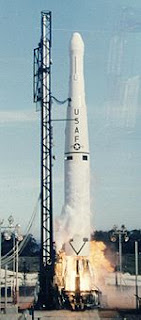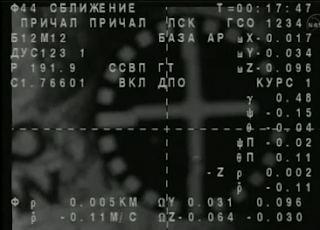
Crew Patch for mission TMA-02M.
The second half of the Expedition 28 crew lifted off in their Soyuz rocket from Baikonur at about 2:15 p.m. MDT yesterday. The crew consists of Soyuz Commander cosmonaut Sergei Volkov, NASA astronaut Mike Fossum, and Japanese astronaut Satoshi Furukawa. The rocket took off at night, making a brilliant display of rapid ascent to Earth orbit. Russian video being what it is, however, means we did not have great video of the stage separations. We did, though, get good video feed of astronaut preparations and views of the crew inside the capsule on their journey to space.

Russian Soyuz rocket on pad.
The crew started their trip with a traditional autographing of the doors of their rooms at Star City. Then, after suiting up, technicians adjusted their suits and they were transported to the pad. Notable was the presence of legendary cosmonaut Alexei Leonov, first man to walk in space. He looked to be in good health and spirit as he wished the crew well on their trip.

Astronaut Furukawa signs his door.

The crew leaves their quarters to go suit-up.

Astronauts take turns getting their suits adjusted for the flight. The position of the cosmonaut in the adjusting chair gives you a great image of how cramped they will be in their capsule.

Atop the rocket, the Capsule and escape tower.

Mike Fossum in the right seat (left in view). Waiting for launch.

On their way! Glare from rocket flames makes it hard to see the rocket in the center.

Shaky Cam. Fossum gives a thumbs up during ascent.

Volkov in center seat, Furukawa to the right (left seat). Microgravity in effect, as witnessed by the pen floating above the checklist.

Russian mission control outside of Moscow. The Soyuz will dock with ISS on Thursday.







































